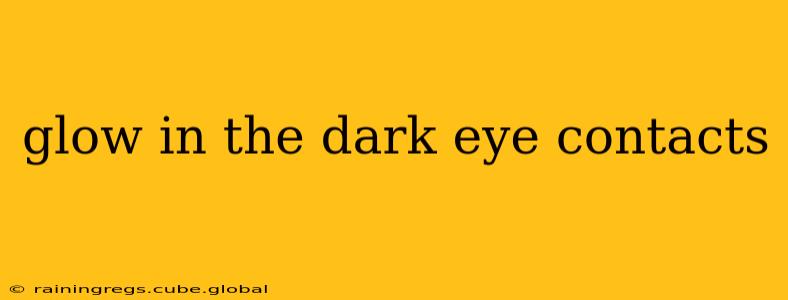Glow-in-the-dark eye contacts have become increasingly popular, adding a dramatic flair to costumes, parties, and even everyday wear. But before you embrace this eye-catching trend, it's crucial to understand the safety aspects, legality, and various types available. This comprehensive guide will address everything you need to know about glow-in-the-dark eye contacts, ensuring you make informed choices.
Are Glow-in-the-Dark Eye Contacts Safe?
This is arguably the most important question. The safety of glow-in-the-dark eye contacts hinges entirely on their source and composition. Legitimate, FDA-approved cosmetic contact lenses are generally safe when handled and used correctly. However, many inexpensive, unregulated options available online pose significant risks. These may contain harmful chemicals, be poorly manufactured leading to discomfort or even damage to your eyes, and may not fit properly.
Never purchase glow-in-the-dark contacts from unverified sources. This includes flea markets, unlicensed online vendors, or individuals selling them privately. Your eye health is paramount, and risking it for novelty contacts is simply not worth it.
How Do Glow-in-the-Dark Eye Contacts Work?
Glow-in-the-dark eye contacts achieve their luminescent effect through the use of phosphorescent pigments embedded within the lens material. These pigments absorb light (typically UV light) and then slowly release it over time, creating a glowing effect. The intensity and duration of the glow vary depending on the quality of the pigments and the amount of light absorbed.
What are the Different Types of Glow-in-the-Dark Contacts?
While many claim to offer "glow-in-the-dark" effects, the actual luminescence can vary. Some options merely offer a subtle shimmer or light reflection, while others offer a more pronounced glow. You'll find various designs, such as:
- Solid Colors: These contacts are uniformly colored, offering a consistent glow across the entire lens.
- Patterned Designs: These feature various patterns or designs incorporated into the lens, creating a unique glow effect. Think stars, galaxy patterns, or even more intricate designs.
- UV Reactive: These lenses primarily glow when exposed to ultraviolet (UV) light, producing a brighter effect under black lights or similar sources.
Where Can I Buy Safe Glow-in-the-Dark Contacts?
Always prioritize safety. Purchase only from reputable eye care professionals or licensed online retailers who sell FDA-approved contact lenses. These vendors will be able to guide you through the correct fitting process and provide information on proper care and handling.
Are Glow-in-the-Dark Eye Contacts Legal?
The legality of glow-in-the-dark contacts depends on your location and the specific regulations regarding cosmetic contact lenses. However, purchasing contacts from unauthorized sources is often illegal, regardless of their luminescence. Always ensure your chosen retailer is compliant with local and national regulations.
How Do I Care for Glow-in-the-Dark Eye Contacts?
Caring for glow-in-the-dark contacts is identical to caring for regular contact lenses. This includes:
- Proper Cleaning: Use the recommended lens solution to clean and disinfect your contacts daily.
- Storage: Store contacts in a sterile case with fresh solution when not in use.
- Replacement Schedule: Follow the manufacturer's instructions regarding lens replacement. Do not overuse your lenses.
Can I Make My Own Glow-in-the-Dark Contacts?
Absolutely not. Attempting to modify or create your own contact lenses is extremely dangerous and could lead to serious eye injury or even blindness. The materials and processes involved require specialized expertise and equipment. Never attempt this.
What are the Risks of Using Unsafe Glow-in-the-Dark Contacts?
Using unsafe glow-in-the-dark contacts can lead to numerous issues, including:
- Eye infections: Poorly made contacts can harbor bacteria, leading to serious infections.
- Corneal abrasions: Ill-fitting or improperly handled contacts can scratch the cornea.
- Vision impairment: Damage to the cornea or other eye structures can result in blurred vision or even permanent vision loss.
- Allergic reactions: Materials used in low-quality contacts can trigger allergic reactions.
This comprehensive guide highlights the importance of responsible use and purchasing of glow-in-the-dark contacts. Prioritize your eye health and choose safety over fleeting novelty. If you have any concerns or questions, always consult with a qualified eye care professional.
